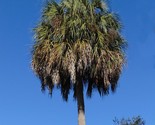10 Seeds Cabbage Palm Sabal Palm Sabal Palmetto
Ships from
United States

Shipping options
Seller handling time is 2-14 business days Details
This reflects the seller's handling time and may not include time spent in transit.
If you have questions about shipping, please contact the seller.
No shipping price specified to GB
Ships from
United States

Return policy
None: All purchases final
Payment options
PayPal accepted
PayPal Credit accepted
Venmo accepted
PayPal, MasterCard, Visa, Discover, and American Express accepted
Maestro accepted
Amazon Pay accepted
Nuvei accepted
Shipping options
Seller handling time is 2-14 business days Details
This reflects the seller's handling time and may not include time spent in transit.
If you have questions about shipping, please contact the seller.
No shipping price specified to GB
Ships from
United States

Return policy
None: All purchases final
Payment options
PayPal accepted
PayPal Credit accepted
Venmo accepted
PayPal, MasterCard, Visa, Discover, and American Express accepted
Maestro accepted
Amazon Pay accepted
Nuvei accepted
Item traits
| Category: |
Seeds & Bulbs
|
| Quantity Available: |
10 in stock
|
| Condition: |
New
|
| UPC: |
Does Not Apply
|
| USDA Hardiness Zone: |
10 (30 to 40 °F), 11 (40 to 50 °F), 8 (10 to 20 °F), 9 (20 to 30 °F)
|
| Brand: |
Unbranded
|
Listing details
|
Seller policies:
|
View seller policies
|
|
Shipping discount:
|
Seller pays shipping for this item.
|
|
Posted for sale:
|
More than a week ago
|
|
Item number:
|
871038030
|
10 Seeds Cabbage Palm Sabal Palm Sabal Palmetto
The Cabbage palmetto (Sabal palmetto) is the most northerly and abundant of the native tree palms. Other names sometimes used are Carolina palmetto, common palmetto, palmetto, and cabbage-palm. This medium-sized unbranched evergreen palm commonly grows on sandy shores, along brackish marshes, in seacoast woodlands of Southeastern United States and throughout peninsular Florida. It can tolerate a broad range of soil conditions and is often planted as a street tree. Abundant fruit crops provide a good supply of food to many kinds of wildlife. It is exceedingly drought tolerant, salt tolerant, cold hardy, pest and disease free, the Sabal Palm is a foolproof choice for any Florida landscape. It thrives on available rainfall and the meager nutrients found in Florida’s sandy soils, making it a perfect choice for sustainable landscapes. This resilient tree endures fire, flood, freeze, and hurricane, and recovers remarkably well after being dug from the wild, carried across the state, and then planted into harsh urban sites. The heart of the palm (the bud of unopened leaves) has traditionally been eaten as “Swamp Cabbage,” hence the names “Cabbage Palm” or “Cabbage Tree.” Seminole and Miccosukee Indians refer to the Sabal Palm as the “tree of life,” for it has provided them shelter, food, tools, utensils, and fiber for baskets and netting. The Sabal Palm often hosts other plants in its “boots,” including Strangler Fig, Wild Grape, Virginia Creeper, and a variety of beautiful threatened and endangered ferns.
Growing Instructions
1. Fill several pots with drainage holes in the bottom with a well-drained potting mix such as peat/perlite, sandy soil or a sandy/potting soil mix.
2. Sow the seeds on the surface and cover them with 1/4 inch of soil.
3. Water the seeds and let the water drain from the pots. The soil needs to be moist but well-drained so water them regularly but don't let the soil become water-logged. If the pots have dishes at the base, remove the dishes so that the water can drain from the pots.
4. Put the pots in a warm, sunny location. Sabals can grow in the sun or shade but they do better in full sun.
5. When the seedlings have a few leaves, they can be transplanted into their permanent location.
